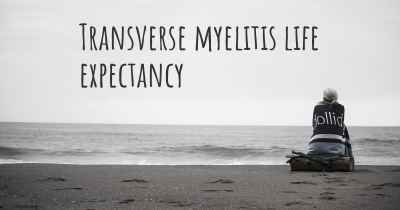What are the best treatments for Transverse myelitis?
See the best treatments for Transverse myelitis here

Transverse myelitis (TM) is a rare neurological condition characterized by inflammation of the spinal cord. It can cause a range of symptoms, including weakness, sensory disturbances, pain, and bladder or bowel dysfunction. The exact cause of TM is often unknown, but it is believed to be an autoimmune disorder where the body's immune system mistakenly attacks the spinal cord.
While there is no cure for TM, there are several treatments available that can help manage the symptoms, promote recovery, and prevent further damage. The choice of treatment depends on the severity of the condition and individual patient needs. It is crucial for individuals with TM to work closely with a healthcare team, including neurologists, physiatrists, and physical and occupational therapists, to develop a comprehensive treatment plan.
1. High-dose corticosteroids:
Corticosteroids such as methylprednisolone are commonly used as the first-line treatment for TM. These powerful anti-inflammatory drugs help reduce spinal cord inflammation and minimize nerve damage. High-dose corticosteroids are typically administered intravenously over a few days, followed by a gradual tapering of the dosage.
2. Plasma exchange (plasmapheresis):
Plasma exchange is a procedure that involves removing a patient's blood, separating the plasma (which contains harmful antibodies), and replacing it with a substitute solution. This treatment aims to remove the antibodies responsible for attacking the spinal cord and replace them with healthy antibodies. Plasma exchange is often considered when corticosteroids fail to provide sufficient improvement.
3. Intravenous immunoglobulin (IVIG):
Intravenous immunoglobulin is a treatment that involves infusing a patient with a solution containing healthy antibodies obtained from donated blood. IVIG works by modulating the immune response and reducing inflammation. It is sometimes used as an alternative to plasma exchange or in combination with corticosteroids.
4. Rehabilitation therapy:
Rehabilitation therapy plays a crucial role in the management of TM. Physical therapy focuses on improving strength, mobility, and coordination, while occupational therapy helps individuals regain independence in daily activities. Rehabilitation programs are tailored to each patient's specific needs and may include exercises, assistive devices, and techniques to manage pain and spasticity.
5. Symptomatic treatment:
Various medications can be prescribed to manage specific symptoms associated with TM. Pain medications such as nonsteroidal anti-inflammatory drugs (NSAIDs) or opioids may be used to alleviate pain. Antispasmodic medications can help reduce muscle spasms and spasticity. Bladder and bowel medications may be prescribed to manage urinary or fecal incontinence. It is important to consult with a healthcare professional to determine the most appropriate medications for individual symptoms.
6. Supportive care:
TM can have a significant impact on an individual's quality of life. Supportive care measures aim to address the emotional and psychological aspects of living with a chronic condition. Counseling or psychotherapy can help individuals cope with the challenges of TM and provide strategies for managing stress and anxiety. Support groups and online communities can also offer valuable support and a sense of belonging.
It is important to note that the effectiveness of treatments may vary from person to person, and a combination of therapies may be necessary to achieve the best outcomes. Additionally, early intervention and prompt treatment initiation are crucial for optimizing recovery and minimizing long-term complications.
Initial treatments and management of the complications of transverse myelitis include:
Intravenous corticosteroid drugs may decrease swelling and inflammation in the spine and reduce immune system activity. Such drugs may include methylprednisolone or dexamethasone. These medications may also be given to reduce subsequent attacks of transverse myelitis in individuals with underlying disorders.
Plasma exchange therapy (plasmapheresis) may be used for people who don’t respond well to intravenous steroids. Plasmapheresis is a procedure that reduces immune system activity by removing plasma (the fluid in which blood cells and antibodies are suspended) and replacing it with special fluids, thus removing the antibodies and other proteins thought to be causing the inflammatory reaction.
Intravenous immunoglobulin (IVIG) is a treatment thought to reset the immune system. IVIG is a highly concentrated injection of antibodies pooled from many healthy donors that bind to the antibodies that may cause the disorder and remove them from circulation.
Pain medicines that can lessen muscle pain include acetaminophen, ibuprofen, and naproxen. Nerve pain may be treated with certain antidepressant drugs (such as duloxetine), muscle relaxants (such as baclofen, tizanidine, or cyclobenzaprine), and anticonvulsant drugs (such as gabapentin or pregabalin).
Antiviral medications may help individuals who have a viral infection of the spinal cord.
Medications can treat other symptoms and complications , including incontinence, painful muscle contractions called tonic spasms, stiffness, sexual dysfunction, and depression.
Following initial therapy, it is critical part to keep the person’s body functioning during the recovery period. This may require placing the person on a respirator in the uncommon scenario where breathing is significantly affected.
Posted Aug 16, 2022 by Transverse Myelitis Folks Blue Crew
Posted Feb 23, 2017 by Nancy 715
Posted Feb 23, 2017 by Jen 1001
Posted Feb 23, 2017 by Cathy 1000
Posted May 17, 2017 by Marella Cairns 1050
Posted May 17, 2017 by Justin 1152
Posted Jul 24, 2017 by Hagen 2730
Posted Jul 25, 2017 by Mindy 2000
Posted Jul 25, 2017 by Conrad 2200
Physical therapy and aqua therapy can help get back some of the lost muscle strength and assist in learning how to walk again.
Posted Sep 10, 2017 by Kevin Weilacher 3420
Posted Sep 10, 2017 by Barbara 400
Posted Sep 10, 2017 by Amy 600
Posted Sep 29, 2017 by Lindz1980 905
Posted Sep 29, 2017 by Samantha Bryce 2065
Posted Sep 30, 2017 by Kimberlee 300
Posted Oct 6, 2017 by Chuck 2000
Posted Nov 30, 2017 by mikado54mark 3150
Posted Jan 18, 2018 by JoeyButler 500
Posted Feb 27, 2018 by Gill 1800
Posted Jun 1, 2018 by Clay Garner 2500
However, most people with TM are initially placed on high doses of steroids - usually prednisolone, which are gradually tapered.
Another treatment I have received is methotrexate - an autoimmune suppressant.
Over the years I have been given literally tons of other meds to "manage my condition / side effects".....
Please note, that I have chosen not to take any meds (with the extremely reluctant agreement from my GP and Neuro) as I hated the side effects. But I am NOT a MEDICAL PROFESSIONAL and therefore CANNOT & WILL NOT recommend taking / not taking ANY particular meds as this is an extremely personal choice, and must be done in an informed manner alongside your health professionals.
Posted Jul 30, 2018 by Ally 1060
Posted Jun 1, 2021 by Gary 3550
Posted Jun 1, 2021 by Bob1974 800
Posted Aug 17, 2022 by gloria_kazan 7450
Posted May 29, 2017 by Adriana E. 2000
Posted May 29, 2017 by Leandro 2200
Posted Aug 8, 2017 by Dani 2000
Posted Nov 8, 2017 by Lorena 3050








